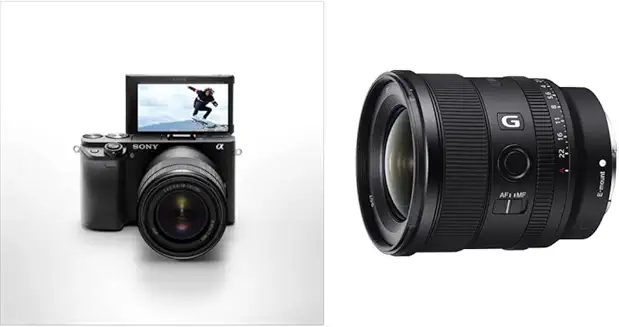2023 Best Cameras in India – Top List Ranked & Reviewed
Last Updated April 08, 2025
Our Top 3 Picks (Quick List)
When buying a camera, it’s essential to consider various features to ensure you make the right choice. Beyond the basics of sensor size, megapixel resolution, and lens options, factors like autofocus system, image stabilization, burst mode, video recording capabilities, connectivity options, weather sealing, and battery life play crucial roles.
By understanding these features and their significance, you can make an informed decision and find a camera in India that suits your needs, whether you’re a professional photographer or an enthusiastic hobbyist.
Top 10 Cameras List in April 2025
Essential Features to Look For When Buying a Camera
The word “camera” has been derived from “camera obscura,” which means a dark chamber. The earlier generations of cameras consisted of instant cameras or Polaroid cameras. These cameras used self-developing film rolls to print the pictures after they were captured. However, with the rise of digital cameras, these cameras are no longer used and have become obsolete.
Digital cameras are similar to traditional cameras, but they digitally capture images. There are four kinds of digital cameras available in the market: DSLR, compact, bridge, and mirrorless. DSLR and mirrorless cameras offer interchangeable lenses.
Digital cameras are highly popular among people today, and many companies manufacture cameras with an amazing range of features for customers. With so many camera options in the market, it can be confusing to choose the best camera. However, keeping some factors in mind will help you make an informed decision.
How to Choose a Camera?
As a customer, if you want a digital camera with good features, you will be investing a good amount of money. So, keeping the following factors in mind will help you make the right purchase.
Size of the sensor
When it comes to flexibility of exposure and picture quality, sensor size is crucial. The most important thing to consider is the sensor size and the size of the photosite on the sensor. The larger the size of the photosite, the more light it will capture, resulting in more information being captured. More information captured by the camera’s processor leads to better picture quality.
You will notice the difference when taking pictures in dim and bright light conditions. In bright light conditions, small sensors on compact digital cameras may not record details in the brightest or darkest areas, resulting in blocked shadows and extreme highlights. These issues cannot be corrected to improve the picture quality.
Megapixel resolution
While companies emphasize the megapixel count on their cameras, in reality, it is relatively less important when purchasing a good quality digital SLR. The number of megapixels determines the size at which the image can be printed theoretically. However, it’s worth noting that a DSLR camera with 5 to 6 megapixels can produce good A-3 sized prints if the original picture has good exposure and is edited properly.
An eight-megapixel camera has only thirty percent more photosites than a 6-megapixel camera, which becomes negligible when viewing the picture from the correct distance.
Brand loyalty
Photographers often develop loyalty to the brands from which they initially purchased their SLR cameras and lenses. This loyalty is logical as it is better to buy a camera body that is compatible with the lenses. However, this may not always be the best option to follow.
DSLR camera manufacturers change the focal length of a 35mm lens by a Lens Multiplier Factor (LMF) of at least 2x. This means that the wide-angle view of a 24mm lens will be the same as a 36mm lens. Additionally, 35mm lenses are heavier than digital lenses and mainly designed for filmmaking, with a different body structure. They might not produce good images on a DSLR body.
Lenses
Entry-level DSLRs are usually sold with a medium-range zoom lens. However, many companies now offer two lenses with the camera. The additional lens is often a tele-zoom with a focal length of about 70-200mm in the 35mm format. A twin-lens kit provides good value as it offers two different types of lenses to start with.
Camera body
Entry-level DSLR models may look similar, but there are factors to consider when making a selection. Some cameras have LCD view screens, enabling better image viewing. Others have pop-out screens at the back, ideal for capturing pictures at different angles. Some models even have touchscreens for easy navigation. If you have large hands, opt for a larger-bodied camera to avoid feeling cramped.
Most entry-level digital cameras have bodies made from polycarbonate, making them lightweight and easy to carry. Higher-level digital cameras have sturdier bodies.
Different modes and editing features
DSLR cameras come with a wide range of modes like landscape, night, portrait, and others. However, some entry-level cameras may have additional features to guide users on camera usage.
When starting out with a digital camera, you can use the Auto mode, which helps by adjusting the aperture and shutter speed. As you gain experience and confidence, you can switch to manual mode and experiment with different shutter speeds and aperture levels based on the desired picture.
Many cameras in the market offer quick editing features, allowing you to edit pictures immediately after capturing them. You can use filters, adjust lighting or contrast, and change exposure settings. While editing pictures on a laptop using photo editing software is easier, editing on the camera itself is a convenient option when time is limited and immediate picture sharing is necessary.
Pricing
Pricing is another important factor to consider. Entry-level digital cameras are affordably priced to cater to photography enthusiasts starting out. However, if you want a better model with advanced features and high-quality lenses, you may need to invest more money.
Autofocus System
The autofocus system determines how quickly and accurately the camera can focus on a subject. Look for cameras with advanced autofocus systems that offer fast and precise focusing, especially if you plan to shoot fast-moving subjects or in low-light conditions.
Image Stabilization
Image stabilization helps reduce blurriness caused by camera shake when shooting handheld or in low-light situations. Optical image stabilization (OIS) or sensor-shift stabilization are common types to look for, as they compensate for camera movement and produce sharper images.
Burst Mode
Burst mode allows the camera to capture a rapid series of shots in quick succession. This feature is particularly useful for capturing action or fast-moving subjects. Consider cameras with a high frames-per-second (fps) rate in burst mode if you’re interested in sports or wildlife photography.
Video Recording Capabilities
If you plan to shoot videos with your camera, consider its video recording capabilities. Look for features like 4K resolution, high frame rates, and the availability of manual controls for video settings.
Connectivity Options
Cameras with built-in Wi-Fi or Bluetooth capabilities allow for easy sharing and transferring of photos and videos to other devices or online platforms. Some cameras even offer NFC (Near Field Communication) for quick and seamless connection with compatible devices.
Weather Sealing
If you intend to use your camera in challenging weather conditions or outdoor environments, consider cameras with weather sealing. Weather-sealed cameras offer protection against dust, moisture, and splashes, ensuring durability and reliability in adverse conditions.
Battery Life
Pay attention to the battery life of the camera, especially if you plan to shoot for extended periods without access to charging. Look for cameras with long-lasting batteries or the option to use extend
Deciding to buy a DSLR camera is a significant step, and choosing the right camera is essential for continuing great photography, whether you are a professional photographer or pursuing photography as a passion. Keep the above-mentioned factors in mind to make an informed decision when purchasing a camera.












